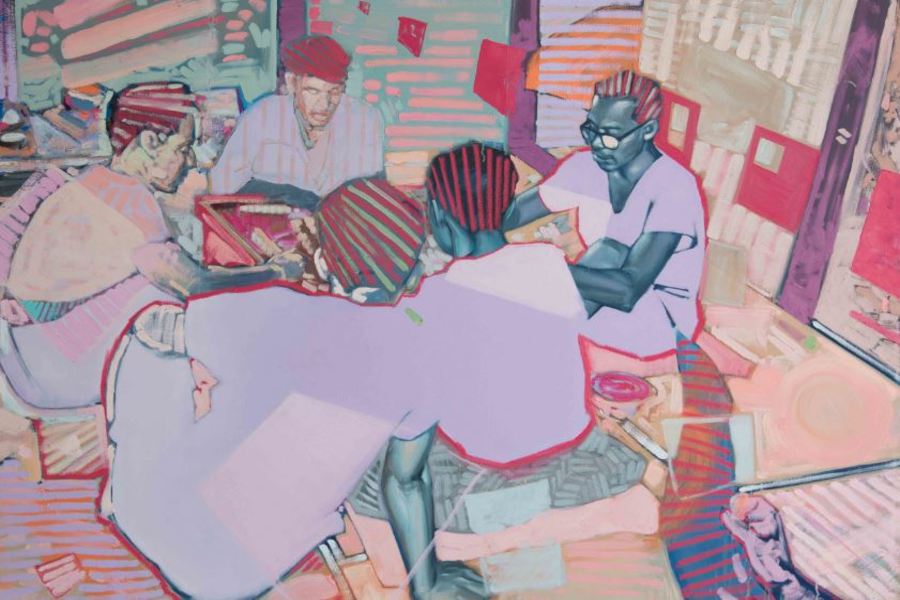
Shane Berkery is perhaps the most exciting young painter to emerge from the Irish art scene in recent years. Having grown up in Japan, New York and finally Dublin, Berkery’s ambulatory and multicultural roots are influential in his painting. His vision of the world and striking use of colour is both neoteric and nostalgic. By taking large inspiration from an extensive collection of photographs which his grandfather took of 1950’s Japan, Berkery juxtaposes hyper-realistic portraits of men and women in suits or traditional Japanese attire with quixotic backgrounds which elicit a sort of dreamy illusionism, and perhaps even elements of magical realism.
Many of his compositions verge on anamorphic perspective in which the pastel coloured subjects appear to share a physical space with the viewer, demonstrating his outstanding technique in figurative painting. In creating a vista of 1950’s Japan funnelled through bubblegum tones of light pinks, blues and yellows, the artist evokes an era which many of us have never lived through including Berkery himself, yet one of which we have a somewhat imaginatory memory, whereby certain aspects are exaggerated or even fabricated in our minds and on canvas.
Berkery came into controversy in the lead up his final year exhibition, when he painted a nude portrait of the NCAD director as a critique of way in which the college was being run. When asked by the college to take it down due to the threat of legal proceedings, Berkery obliged. Speaking to The University Times, Berkery admits: “It didn’t make me angry, it didn’t make me anything. I painted it pretty much as a joke and a little bit of a protest because the reputation of the college was and is falling apart.”
It certainly raises the question of artistic freedom, condemning the hypocrisy of an institution which intrinsically advocates for creative autonomy, yet also restricts students. Effectively, the piece reflected on the sort of constrained artistic liberty afforded to students. In the sake of parity, the diptych also included a nude portrait of himself, “just to make it fair”. Particularly during a time when protest through the means of art is becoming ostensibly inherent to the workings of 21st century activism. The incident galvanised Berkery’s status as an up-and-coming artist to watch. Reflecting on the impact of the provocative work Berkery adds “the newspaper said it was censorship, I didn’t feel it at the time but I think it worked out well”.
It certainly seems to have worked out well for the artist. Post art school life has been kind to Berkery. He has exhibited in the Saatchi Gallery in London, has had two shows in the Molesworth Gallery and has also been shortlisted for the 2017 Hennessy Portrait Prize among other illustrious projects. Berkery maintains a very impressive oeuvre for only 27 years of age. His success perhaps can be attributed to the fact that he is constantly changing his technique: “I don’t want to get stuck in a rut. Every time I start the painting differently, or use different colour combinations. Sometimes I’ll put a wash down first, or I’ll use charcoal to draw out the figure”. In changing the way in which he forms a picture, the artist makes the process more interesting for himself. “I approach every painting as practice so I’m not very precious about it”. Recently the artist has been taking more photos himself, the subjects of which will become the essence of his painting.
Painting representation very strongly is a big goal of Berkery’s. He vehemently believes in having good draughtsmanship, criticising the approach of painting in simplistic style so as to mitigate achieving proper technical skill: “A good example is Picasso who was perfect at figure drawing then went towards the more abstract stuff”. Berkery eschews the overtly conceptual convention of contemporary art in his process. He does not subscribe to the often verbose language of the art world and prefers that “the painting should speak for itself”. Perhaps this is why Berkery’s work is so refreshing and innovative: his relaxed approach to an often isolationist sphere of high concept art emboldens his practice. He even constructs his own canvases, allowing him a more affordable and adaptable preliminary base with which to create work.
Berkery exudes a casual air of ingenuity, the unpredictability of which stems from a quiet confidence in his own ability and unique approach to contemporary art.






